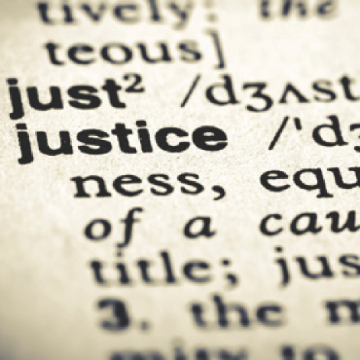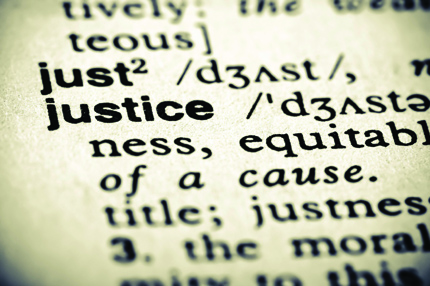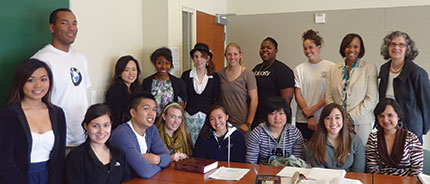
Living Values through the Center for Social Justice and Public Service
"If your brother becomes poor... uphold him."
LEVITICUS 25:35"Justice, justice you shall pursue."
DEUTERONOMY 16:20We begin this essay by contextualizing our commitments through our own stories and traditions, for these familial and religious roots inspire and ground our teaching, writing, and larger professional work within law, social justice, and public service.
STEPHANIE WILDMAN: My mother was a teacher and my father was a lawyer, so some might say that my career as a law professor was a kind of destiny. But for me, a white Jewish woman who grew up in an Orthodox home, teaching at a Jesuit university was not an obvious career path. But the Jesuit commitment to inclusive excellence as practiced at Santa Clara University has helped me and my work to flourish. Jesuit values mesh well with tikkun olam, the Jewish tradition of repairing the world.
DEBORAH MOSS-WEST: I was raised in a traditional Baptist family that stressed Christian values and education. I have always had a strong connection to my faith. It was no surprise in 1990 that upon arrival on Santa Clara University’s campus to attend law school, I felt a strong connection to the University and Jesuit values. I hoped this setting would allow me to be myself. Now as an employee twenty years later, I have come full circle—continuing to nurture my thirst for knowledge, to learn from and teach others, and to help spread the Gospel.
According to a 2012 American Bar Association study, at least 40 percent of low- and moderate-income households experience a legal problem each year. Yet studies show that the collective legal aid effort is meeting only about 20 percent of the legal needs of low-income people.(1)
Unlike defendants in criminal cases, low-income parties in most civil proceedings have no right to appointed counsel.(2) Low-income parties’ legal needs often go unmet when potential litigants are without resources to hire an attorney. The Santa Clara Law Center for Social Justice and Public Service tries to address this justice gap in many ways, but especially by educating students to work with underserved communities and facilitating avenues for students to engage in public service work, thus increasing available representation to marginalized, subordinated, and underrepresented clients and causes. Although the responsibility to help others is universal, the call has a meaning that is inextricably tied to the admonishment in Leviticus 25:35, “uphold him”—we are to help others. Santa Clara School of Law’s commitment to educating lawyers of “conscience, competence, and compassion” highlights Jesuit, Christian values, which are also Jewish values.(3)
Centers for Social Justice can play the role of providing an institutional context and support for this undertaking of closing the justice gap that brings students, faculty, staff, alumni, and members of the community together while increasing the teaching, learning, and service opportunities that can provide more legal assistance to underrepresented communities. The law school curriculum is an essential component to providing knowledge about and access to this social justice work. Course offerings, including certificates in public interest and social justice law, help students develop the vocabulary and theoretical background that will infuse their practical work. A certificate program, along with the center’s extracurricular activities and pro bono emphasis, creates an institutional context in which students who want to pursue social justice work, either as a career or as a lifelong commitment in any law practice can find support and friendship, and thrive.
 |
Scholars like Gerald López have characterized education for social justice as “The Work We Know So Little About.”(4) Work against subordination does require knowledge—in fact, many kinds of knowledge. In Santa Clara’s law and social justice classes, we seek to convey such knowledge. The primary text we use in these courses underlines three aspects of lawyering for social justice.(5) The text and the course begins with the organization of the legal profession: aspirations, why come to study law, the nature of legal education, access to justice, kinds of social justice practice, and an overview of working with communities. It then shifts gears to address the development of social justice law, including the nature of rights-based claims and a history of struggles for social justice in areas like work, welfare, and livelihood, essential to basic human needs. The text also looks at social justice issues key to the practice of democracy: education, voting, protection against harm, and the judiciary and role of judges. The materials ask whether one can be a judge for social justice, just as the course considers lawyering for social justice. It next turns to questions of politics, legal work, and social change. The text and the course conclude with a reading on “becoming a lawyer, staying yourself,”(6) giving modern-day meaning to the mandate to pursue justice and help others, illustrating many kinds of actions, modes of law practice, and struggles in that movement toward justice.

It is a full semester, and to complement this theoretical reading, the law students do original case study research, finding a social justice case and interviewing the parties, the lawyers, community groups, and if possible the judge. Student evaluations support the value of the course:
“The course was one of the most important classes that I’ve taken in law school, because it really taught me what it means to be a lawyer and the responsibilities that the profession carries with it.”
“The most valuable part of the course (and to my legal education and learning in general) was the case study. Being able to look at a legal case or issue and interview the ‘players’ and analyze the challenges presented was a really valuable experience.”
“The case study enabled us to speak with attorneys who have incorporated social justice work into their everyday practice.”
As these descriptions suggest, social justice education reaches students, contributing to their lifelong learning and commitment.
In an exciting new class, we are also team teaching this law and social justice course material to undergraduate students, who complement the reading and class discussion with a two-hour-per-week community-based learning placement. As one student explained:
Social justice education confers the possibility to each person that she or he can make a difference in the world ... Students' lived experience, building practice from those texts, reinforces the message that "Yes, we can" seek justice and help our communities.
“Our assignment: put a face to the legal theory we were studying in the class Law and Social Justice. The place: a local community center—perhaps a soup kitchen or a legal clinic. I found myself drawn to Casa de Clara in San Jose. The description for it read: ‘Interact and have dinner with homeless women (and young children) in an intimate, homelike shelter.’”
“It’s one thing to read about complexities... but that learning really hits home when you’re helping a homeless woman navigate the complex process of filing a request for food stamps.”(7)
Social justice education confers the possibility to each person that she or he can make a difference in the world. As the Honorable Cruz Reynoso has said about making changes in the legal system, “Si, se puede!”(8) The texts in the classroom echo biblical mandates. “If your brother becomes poor...uphold him” (Leviticus 25:35). “Justice, justice you shall pursue” (Deuteronomy 16:20). Students’ lived experience, building practice from those texts, reinforces the message that "Yes, we can" seek justice and help our communities.
STEPHANIE M. WILDMAN writes extensively in the areas of social justice, race, gender, and the law. Her book Privilege Revealed: How Invisible Preference Undermines America (with contributions by Margalynne Armstrong, Adrienne D. Davis, and Trina Grillo) won the 1997 Outstanding Book Award from the Gustavus Meyers Center for Human Rights. Professor Wildman was the founding director of the Center for Social Justice at the University of California at Berkeley School of Law (Boalt Hall) and currently serves as John A. and Elizabeth H. Sutro Professor of Law and Director of the Center for Social Justice and Public Service at Santa Clara University School of Law.
DEBORAH MOSS-WEST received her J.D. from Santa Clara University School of Law in 1994 and has been Assistant Director at the Center for Social Justice and Public Service since 2008. Prior to joining Santa Clara Law, Moss-West worked at the East Bay Community Law Center (EBCLC) for eight years, serving as Deputy Director and Development Officer.
Endnotes
*For an expanded version of many of the ideas discussed in this essay, see Deborah Moss-West and Stephanie M. Wildman, “A Social Justice Lens Turned on Legal Education: Next Steps” (37 Journal of the Legal Profession 2013).
- South Carolina Lawyers Serving the Public Good, The Need for Pro Bono (2012), http://www.probono.net/sc/.
- See Gideon v. Wainwright, 372 U.S. 335 (1963), holding indigent criminal defendants have a right to counsel in all criminal trials; noting the right to counsel essential to a fair trial. See also Louis S. Rulli, “On the Road to Civil Gideon: Five Lessons from the Enactment of a Right to Counsel for Indigent Homeowners in Federal Civil Forfeiture Proceedings,” Journal of Law and Policy 19, no. 2:683 (2011), detailing the movement for a right to a “civil Gideon.” A number of states have expanded the right to counsel in civil cases for certain kinds of legal matters. See Laura K. Abel, “Keeping Families Together, Saving Money, and Other Motivations Behind New Civil Right to Counsel Laws,” Loyola of Los Angeles Law Review 42:1087 (2009), describing statutes in Alabama, Arkansas, Connecticut, Florida, Hawaii, Louisiana, Montana, New York, and Texas; and Claire Pastore, “A Civil Right to Counsel: Closer to Reality?” Loyola of Los Angeles Law Review 42:1065 (2009), detailing a California pilot program.
- See Santa Clara University School of Law, Santa Clara Law: Dean Donald J. Polden, http://law.scu.edu/dean (last visited Nov. 9, 2012).
- Gerald P. López, “The Work We Know So Little About,” Stanford Law Review 42:1 (1989); Stephanie M. Wildman with Beverly Moran & Margalynne Armstrong, “Revisiting the Work We Know So Little About,” UC Irvine Law Review 2:1011 (2012).
- The text for Santa Clara’s Law and Social Justice course is Martha R. Mahoney, John O. Calmore, & Stephanie M. Wildman, Social Justice: Professionals, Communities, and Law 2d 1 (2013), which identifies the goal of social justice practice as serving “marginalized, subordinated, and underrepresented clients and causes.”
- Ibid.
- Liz Carney, “Make It Real,” Santa Clara Magazine, Summer 2011, available at http://www.scu.edu/scm/article. cfm?b=439&c=11541.
- Hon. Cruz Reynoso, in Cruz Reynoso: Sowing the Seeds of Justice (Abby Ginzberg Films 2010), discussing the potential appointment of an Asian American or Native American to the U.S. Supreme Court—“Yes, we can.”